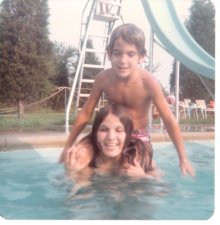I can safely say that public speaking is pretty far down on my list of favorite activities and definitely out of my comfort zone. For me, it’s been a matter of just getting through it and trying not to look foolish. In most (not all) cases, I’ve been successful given this low bar I set for myself. Even so, I’ve usually experienced to some degree the common physical symptoms of shaky voice, racing heart and cotton mouth.
But about seven years ago I had a breakthrough which seemed to be a turning point. I delivered one of the eulogies at my sister’s funeral, one of the most important speeches I would ever make, and in front of many people. But the nerves never kicked in. The words came out in a  calm, articulate and expressive manner. What accounted for this unexpected state of calm? No idea. Can’t explain it. All I can say is that since then, whenever I have had to do any public speaking, there’s anxiety, but it sort of stays in the background without adversely affecting the task at hand. About a week ago, I co-presented a scholarship award in my sister’s honor with much of the same positive results: good eye contact, inflection in voice, steady and calm delivery, and recited from memory to boot (bonus!)
calm, articulate and expressive manner. What accounted for this unexpected state of calm? No idea. Can’t explain it. All I can say is that since then, whenever I have had to do any public speaking, there’s anxiety, but it sort of stays in the background without adversely affecting the task at hand. About a week ago, I co-presented a scholarship award in my sister’s honor with much of the same positive results: good eye contact, inflection in voice, steady and calm delivery, and recited from memory to boot (bonus!)
Interesting story, hopefully. Practical information, not so much. So here are some concrete ways to make our public speaking experiences more effective:
1. Be sure to move your eyes around the room and maintain consistent eye contact to keep people engaged.
2. Depending on the topic, telling a story whenever possible (vs. just reciting facts) is another way to draw in the audience.
3. Don’t forget to breathe (in through the nose, out through the mouth). Doing some quick breathing exercises just before speaking can make a big difference.
4. Keep in mind that many people have short attention spans, and some suffer from A.D.D., or may be incapable of sustaining eye contact . If your audience appears uninterested, it very well may have nothing to do with you or your topic.
5. Try to speak with inflection and don’t forget to smile or even inject humor if appropriate. This will help maintain interest from the audience, even those with short attention spans!
Different things work for different people. For example, I’ve heard that groups such as Toastmasters have been of help to some. What is probably universally true, however, is that good preparation is key. And if you can practice in front of others, even better!
 Having an “attitude of gratitude” helps me keep things in perspective, as well as clarify what’s important and what brings me joy.
Having an “attitude of gratitude” helps me keep things in perspective, as well as clarify what’s important and what brings me joy. Embarrassing yes, but even more so, interesting. Interesting in a few ways: 1. How I got through the first couple of slides with no problem, and then something kicked in on the 3rd slide, the slide with a ton of text on it that I would have to go through in detail -as I’m writing this, I’m thinking that may have also contributed to my “deer-in-headlights” moment. 2. How the fact that there was very little time to prepare/rehearse goes against how anyone, but especially introverts such as myself like to go into a presentation. 3. How making small adjustments can make a significant difference, like sitting back down towards the end of the presentation helped create a more relaxed atmosphere, helped me speak more confidently, and hopefully reclaim the moment.
Embarrassing yes, but even more so, interesting. Interesting in a few ways: 1. How I got through the first couple of slides with no problem, and then something kicked in on the 3rd slide, the slide with a ton of text on it that I would have to go through in detail -as I’m writing this, I’m thinking that may have also contributed to my “deer-in-headlights” moment. 2. How the fact that there was very little time to prepare/rehearse goes against how anyone, but especially introverts such as myself like to go into a presentation. 3. How making small adjustments can make a significant difference, like sitting back down towards the end of the presentation helped create a more relaxed atmosphere, helped me speak more confidently, and hopefully reclaim the moment. 2. Take credit for your work.
2. Take credit for your work. 





